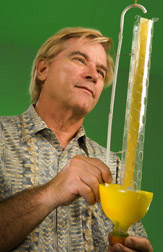This page has been archived and is being provided for reference purposes only. The page is no longer being updated, and therefore, links on the page may be invalid.
Read the magazine story to find out more. |
|
|
Partner Sought To Commercialize Patented Fly Trap
By Sharon DurhamMarch 1, 2007
An improved trap invented by Agricultural Research Service (ARS) scientists could soon help prevent flies from getting into foodstuffs. Called "Flybrella" because of its resemblance to an upside-down umbrella, this low-profile pest control technology was awarded a patent in 2005. Now its inventors are seeking a licensing partner to commercialize the invention.
The trap was designed by entomologist Jerome Hogsette and recently retired chemist David Carlson in the ARS Mosquito and Fly Research Unit, part of the agency's Center for Medical, Agricultural and Veterinary Entomology at Gainesville, Fla. The trap attracts, kills and retains the bodies of house flies and other flying insects.
Flybrella is especially promising as an alternative means of fly control in areas where food products are prepared or stored, since it can replace chemical pest-control methods in these sensitive areas. In controlled laboratory studies, two Flybrellas captured about 98 percent of released flies.
Flybrella is small and lightweight, suitable for hanging on overhead water and power lines where flies tend to rest in industrial kitchens and bakeries. About six feet above the floor seems to be the best height for placing the traps. Flybrella relies on a commercially available natural attractant combined with a toxin to lure hungry flies to their doom. In less than 15 seconds, they are killed by the toxic bait emanating from a perforated tube and then fall into a dome-shaped plastic container at the base of the trap. The bait and toxicant remain effective for about three months.
The trap could be used in supermarkets, restaurants and other establishments where large quantities of food are held. According to Hogsette, Flybrella answers a special need in commercial settings to discreetly attract, kill and collect flies that could be a potential health hazard or a turnoff to customers.
ARS is the U.S. Department of Agriculture's principle scientific research agency.

